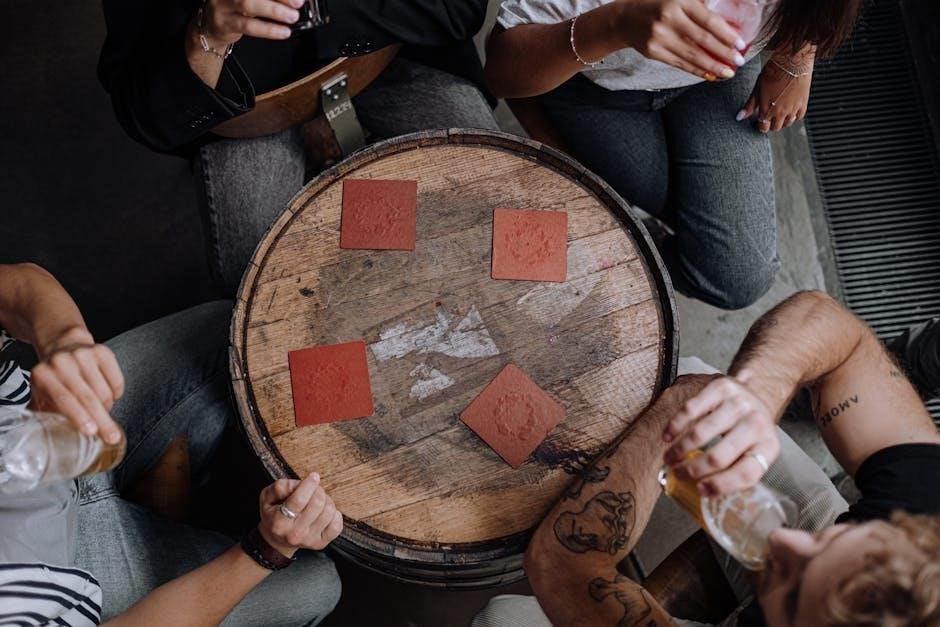beginners guide to drinking wine
Wine drinking is a sophisticated yet accessible experience, blending cultural heritage with sensory exploration. It offers a world of flavors, pairing perfectly with food and conversation, making it a timeless delight for beginners and connoisseurs alike.
What is Wine?
Wine is an alcoholic beverage produced primarily from the fermentation of grapes. The process involves harvesting grapes, crushing them to release juice, and allowing natural or added yeast to ferment the sugars into alcohol. Red, white, and sparkling wines are crafted using different grape varieties and techniques. Climate, soil, and winemaking methods influence the flavor, aroma, and quality of the wine. While other fruits can be used, grape-based wines are the most common. Wine’s complexity and diversity make it a popular choice for both casual enjoyment and special occasions, offering a rich sensory experience that complements food and enhances social gatherings.
The Cultural Significance of Wine
Wine holds a profound cultural significance, deeply rooted in history, religion, and tradition. Across civilizations, wine has symbolized celebration, spirituality, and community. In ancient Greece and Rome, it was central to rituals and social gatherings. Similarly, in many religious practices, wine plays a symbolic role, such as in Christian communion. Wine is often associated with luxury, artistry, and sophistication, reflecting the craftsmanship of winemaking. It also serves as a universal language, bridging cultures and fostering connection. Whether in toasts, ceremonies, or casual meals, wine enhances life’s moments, embodying a timeless blend of heritage and enjoyment that transcends borders and generations.
Types of Wine
Wine is categorized into distinct types, each offering unique flavors and characteristics. Red wines, rich and bold, pair well with hearty dishes. White wines are crisp and refreshing, ideal for lighter meals. Sparkling wines, like Champagne, add celebratory flair, while dessert wines, sweet and indulgent, complement sweet treats. Each type reflects the grape variety, region, and winemaking techniques, providing endless variety for every palate and occasion.
Red Wine
Red wine, crafted from red or black grapes, is known for its bold flavors and rich tannins. Popular varieties include Cabernet Sauvignon, Merlot, and Syrah. The color ranges from deep purple to brick red, with flavors of dark fruit, spices, and earthy notes. Tannins give red wine its structure and longevity, making it ideal for aging. Pair red wine with hearty dishes like red meat, game, or robust cheeses for a harmonious match. For beginners, approachable options like Pinot Noir or Beaujolais are great starting points, offering smooth textures and fruity profiles. Red wine’s complexity and versatility make it a cornerstone of wine culture and a delightful choice for any occasion.
White Wine
White wine, made from white grapes like Chardonnay, Sauvignon Blanc, and Riesling, offers a crisp and refreshing experience. Its flavors range from citrus and floral notes to richer, buttery tones, depending on the grape variety and winemaking techniques. White wines are typically lighter in color and often served chilled, making them perfect for lighter dishes such as seafood, salads, or poultry. For beginners, starting with a dry and fruity option like Pinot Grigio or a sweet Riesling can be an excellent introduction. The acidity in white wine enhances its ability to pair with a variety of cuisines, from delicate appetizers to herb-infused main courses. Whether you prefer a zesty Sauvignon Blanc or a creamy Chardonnay, white wine offers a versatile and enjoyable experience for all palates.
Sparkling Wine
Sparkling wine, known for its effervescence, is a celebratory drink made through a secondary fermentation process, creating its signature bubbles. Popular varieties include Champagne, Prosecco, and Cava. These wines range from sweet to dry, with Champagne often being the most complex due to its traditional production method. Sparkling wines are versatile, pairing well with seafood, appetizers, or even desserts. The acidity and effervescence cut through rich flavors, making them ideal for toasting or special occasions. For beginners, Prosecco is a great starting point due to its affordability and fruity notes. Always serve sparkling wine chilled, around 45°F, and use a flute glass to preserve the bubbles and aroma. Sparkling wine’s lively character makes it a delightful choice for any festive moment, encouraging exploration of its diverse styles and pairings.
Dessert Wine
Dessert wines are sweet, rich, and often served after the main meal. They are made from grapes with high residual sugar, achieved through late harvesting, drying, or noble rot. Popular types include Port, Sauternes, and Icewine. These wines pair beautifully with sweet treats like chocolate, fruit, or cheesecake, and even savory delights like blue cheese. Dessert wines are typically full-bodied and have a velvety texture, with flavors of dried fruit, honey, and caramel. Serve them chilled, around 50–55°F, in smaller glasses to appreciate their complex aromas. For beginners, Moscato and Tawny Port are excellent starting points due to their approachable sweetness and variety of flavors. Dessert wines offer a luxurious end to any meal, perfect for special occasions or indulgent moments. Their sweetness and depth make them a delightful discovery for new wine drinkers.

Essentials for Getting Started
Start with a good corkscrew, quality wine glasses, and a decanter. Serve wine in a calm, comfortable setting to enhance your experience. Experiment with different varieties to find preferences and refine your palate.
Choosing the Right Wine Glass
Selecting the right wine glass enhances the drinking experience by showcasing the wine’s aroma and flavor. The glass’s shape directs the wine to the appropriate part of the palate, affecting taste perception. Red wines benefit from larger bowls to allow oxidation, while white wines thrive in narrower glasses to retain crispness. Sparkling wines require flutes to preserve effervescence. Material matters too—lead-free crystal is preferred for clarity and durability. Handle the glass by the stem to prevent warming the wine. A thin rim is ideal for sipping comfortably. Investing in quality glassware elevates both the sensory enjoyment and the overall appreciation of wine.
Understanding Wine Labels
Wine labels provide essential information to guide your selection. The producer, region, grape variety, and vintage are typically displayed prominently. The region indicates where the grapes were grown, while the vintage refers to the harvest year. Labels may also feature terms like “Appellation” or “Denomination,” which denote the wine’s origin and quality classification. Descriptors like “Reserve” or “Estate Bottled” offer additional insights. Some labels highlight sweetness levels, such as “Dry” or “Sweet,” or specify tannin profiles. Understanding these elements helps you make informed choices. Note that not all labels are equally detailed, and some prioritize artistic design over information. Always check for sulfite warnings if you have sensitivities. The label is your gateway to the wine’s story and quality.

The Basics of Wine Tasting
Wine tasting involves using your senses to evaluate sight, smell, and taste. Hold the glass, swirl the wine, and sip to experience its flavors and finish.
The Four S’s: See, Swirl, Smell, Sip
The Four S’s are essential steps for beginners to fully experience wine. See involves examining the wine’s color and clarity, revealing its age and type. Swirl aerates the wine, releasing its aromas. Smell allows you to detect subtle scents, from fruits to spices, enhancing your anticipation. Finally, Sip lets you taste the flavors, assess the finish, and enjoy the overall complexity. These simple steps transform wine tasting into a meaningful sensory journey, helping beginners appreciate the craftsmanship and beauty behind each bottle.
Wine and Food Pairing
Wine and food pairing is an art and science, enhancing flavors and dining experiences. Match red wines with red meat and robust dishes, while white wines suit lighter fare. Acidic wines cut through richness, balancing bold flavors and textures, creating harmony on the palate for beginners to explore and enjoy.
Basic Principles of Pairing
When pairing wine with food, balance and harmony are key. Complementing flavors involves matching wine notes to dish ingredients, while contrasting flavors creates exciting taste dynamics. Acidity in wine cuts through richness, and tannins pair well with fatty or savory foods. Consider the weight of the dish—lighter wines for delicate flavors, heavier wines for robust meals. Personal preference matters, but classic pairings like red wine with red meat and white wine with fish are reliable starting points. Experimentation is encouraged, but understanding these principles provides a solid foundation for successful pairing. Remember, the goal is to enhance both the wine and the food, creating a harmonious dining experience.
Common Wine and Food Combinations
Classic pairings simplify wine and food matching for beginners. Red wines, like Cabernet Sauvignon, pair well with red meat, while Merlot complements pasta and lean meats. White wines, such as Chardonnay, are ideal for seafood, and Sauvignon Blanc pairs nicely with salads or goat cheese. Sparkling wines, like Champagne, are perfect for celebratory dishes or desserts. Dessert wines, such as Port, complement chocolate or cheese. These combinations provide a reliable starting point, but personal preference always plays a role. Experimenting with these pairings helps develop your palate and discover new favorites, making wine drinking a delightful and personal journey.

Common Mistakes to Avoid
When starting with wine, common mistakes can detract from the experience. Overfilling the wine glass is a frequent error, as it limits aroma appreciation. Serving wine at the wrong temperature is another oversight—red, white, and sparkling wines each have optimal ranges. Swirling excessively or rushing the tasting process can also hinder enjoyment. Additionally, beginners often overcomplicate food pairings, while simplicity can be just as effective. Finally, neglecting proper wine storage conditions, such as light exposure and temperature fluctuations, can degrade the wine’s quality. Avoiding these mistakes helps create a more enjoyable and authentic wine-drinking experience for newcomers.
Wine Etiquette for Beginners
Mastering basic wine etiquette enhances the drinking experience. Hold the glass by the stem to avoid warming the wine with your hand. When swirling, do so gently to release aromas without spilling. Never fill a wine glass to the brim, as this limits the ability to swirl and appreciate the bouquet. When serving multiple wines, start with whites before reds and young wines before aged ones. In a restaurant, the person who ordered the wine typically tastes it first. During a toast, make eye contact and clink glasses gently. Lastly, never leave a wine glass empty; offer a refill if hosting. Respect and attentiveness are key to enjoyable wine etiquette.
Wine and Health
Wine and health go hand in hand when consumed responsibly. Moderate drinking may offer benefits like antioxidants and heart health improvements. However, overconsumption can lead to health issues, so balance is key. Always consider personal tolerance and consult a healthcare provider for specific guidance.
Drinking in Moderation
Drinking wine in moderation is essential for a healthy and enjoyable experience. For most adults, moderation means up to one drink per day for women and up to two drinks per day for men. Exceeding these limits can lead to negative health effects and impair judgment. Wine, like any alcoholic beverage, should be consumed responsibly. Beginners should start with small amounts to understand their tolerance and how their body reacts. Moderation also allows you to fully appreciate the flavors and aromas of wine, enhancing the overall experience. Remember, the goal is to savor and enjoy, not overindulge. Always drink responsibly and stay hydrated to avoid discomfort.
Health Benefits of Wine
Wine, when consumed in moderation, offers several health benefits due to its antioxidant properties. Red wine, in particular, contains resveratrol, which may help protect against heart disease and reduce inflammation. Studies suggest that moderate wine consumption can improve cardiovascular health, lower cholesterol levels, and reduce the risk of certain cancers. Additionally, antioxidants in wine may support brain health and longevity. However, these benefits are tied to responsible drinking habits, as overconsumption can negate positive effects. Wine can be a healthy addition to a balanced diet when enjoyed mindfully and in appropriate amounts. Always prioritize moderation to reap its potential health rewards responsibly.

Final Thoughts
Exploring the world of wine is a rewarding journey that combines sensory pleasure with cultural discovery. For beginners, the key is to embrace curiosity and experiment with different varieties to find personal preferences. Wine is not just a drink but an experience that enhances meals, fosters connections, and offers moments of relaxation. Remember, the best wine is one that brings you joy, regardless of its label or price. As you continue to learn, don’t hesitate to ask questions or seek recommendations. Wine drinking is a lifelong adventure, and every sip is an opportunity to uncover new flavors and traditions. Cheers to your wine journey!
